Feature analysis of EEG signals using SOM
21. Február, 2011, Autor článku: Gráfová Lucie, Elektrotechnika, Medicína
Ročník 4, číslo 2  Pridať príspevok
Pridať príspevok
 The most common use of EEG includes the monitoring and diagnosis of the brain states and their disorders. It is based on the search of characteristic patterns in EEG signals and their evaluation. In terms of signal processing it uses feature analysis, more specifically feature extraction and classification of signal components. The paper deals with the feature study of EEG signals by the self-organizing neural network (SOM).
The most common use of EEG includes the monitoring and diagnosis of the brain states and their disorders. It is based on the search of characteristic patterns in EEG signals and their evaluation. In terms of signal processing it uses feature analysis, more specifically feature extraction and classification of signal components. The paper deals with the feature study of EEG signals by the self-organizing neural network (SOM).
The SOM is an unsupervised method using a neighborhood function to preserve the topological properties of the input space. Resulting algorithm was implemented in MATLAB with many optional parameters that provide possibility to adjust the model to user’s requirements. The graphical user interface was designed as well. General problems of feature analysis, such as extraction of appropriate characteristic features or evaluation of quality of clusters, were also discussed. Presented methodology can be generally applied to each problem requiring feature analysis.
1. Introduction
Feature analysis form an important interdisciplinary area of digital signal and image processing with applications in engineering (including defectoscopy and fault diagnosis), biomedicine (for detection of biosignal or image components) and in many other disciplines.
The paper is devoted to the study of multi-sensor signal processing of noisy non-stationary observations [14]. It presents the use of functional transforms for signal segments feature extraction and their classification by neural networks [7, 4] commonly used and discussed. The use of self-organizing neural networks is included in the graphical user interface proposed.
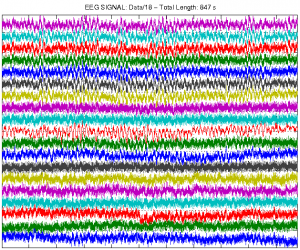
Figure 1: Original EEG signal presenting 19 channels with the additive noise of 50 Hz
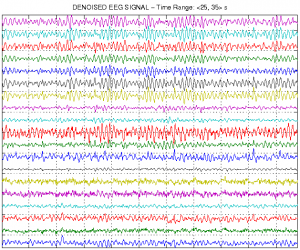
Figure 2: The EEG signal after the removal of the signal noise components
General methods of signal segments classification are studied for EEG signals [12, 11] forming together with magnetic resonance methods the most complex diagnostic tools related to brain activities. To analyse extensive EEG observations it is necessary to use efficient mathematical tools for extraction of important signal segments. Fig. 1 presents a sample of an observed EEG signal segment with results of its denoising in Fig. 2.
2. Signal Preprocessing
Preprocessing of multichannel signals includes digital filtering in the first stage in many applications. Proposed algorithm presented in Fig. 3 and applied for EEG signal processing includes multi-channel signal filtering by finite impulse response (FIR) filters to reject signal component of 50 Hz and to preserve signal frequencies in the range of ⟨0.5, 60⟩ Hz.
Algorithm of multi-channel FIR filtering (of order M) of an EEG signal observed with the sampling frequency Fs
%% EEG Data Filtering %%%
b1=fir1(M,[48 52]/Fs,’stop’);
b2=fir1(M,[0.5 60]/Fs,’bandpass’);
X=filter(b2,1,filter(b1,1,EEG));
The following signal analysis includes the evaluation of principal components in many cases. Analysis of the first principal component can follow.
3. Signal Segmentation and Feature Extraction
Either a selected EEG channel or the first principal component of the multi-channel signal can be used for segmentation. While Bayesian methods can be used for this purpose [5] it is more efficient in the case of EEG signals to detect changes of spectral components in the given signal.
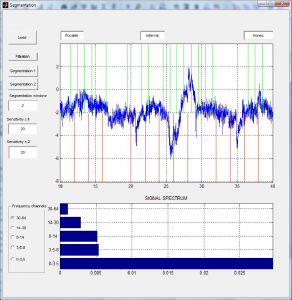
Figure 4: Graphical user interface for segmentation of the EEG signal and average frequency energy of the selected segment in given frequency bands
The proposed method uses two sliding overlapping windows and the whole algorithm is based upon detection of changes of spectral components in given frequency bands. Fig. 4 presents the proposed graphical user interface designed to find signal segments of similar properties in the frequency domain.
Each signal segment must be described by appropriate number of features selected in the appropriate way to define clusters for the following classification. Both time-domain and frequency-domain properties can be chosen to reach this goal. For non-stationary signal it is possible to use also discrete wavelet transform (DWT) [6, 8, 13, 2] and dual-tree complex wavelet transform [13, 1, 3].
Fig. 5 presents EEG signal segments and their analysis by a harmonic wavelet transform [10] resulting in features standing for scales 1, 2 and 3 respectively covering three frequency bands with different time-scale resolutions.
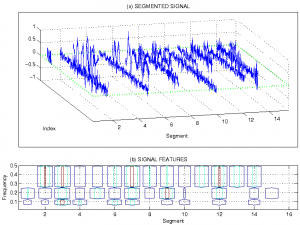
Figure 5: Results of feature extraction presenting (a) EEG signal segments and (b) their wavelet features resulting from a harmonic DWT on scales 1, 2, 3
4. Classification
Classification of signal segments into a given number of classes using segments features can be achieved by various statistical methods. Another approach is based upon the application of self-organizing neural networks using features as patterns for the input layer of neural network. The number of output layer elements is equal to signal classes and must be either defined in advance or it can be automatically increased to create new classes [4].
During the learning process neural network weights are changed to minimize distances between each input vector and corresponding weights of a winning neuron characterized by its coefficients closest to the current pattern. In case that the learning process is successfully completed network weights belonging to separate output elements represent typical class individuals.
Results of signal classification into four classes by a self-organizing neural network are given in Fig. 6 for two selected signal features allowing a simple visualization of segmentation results and visualization of typical class representatives with their features closest to the corresponding cluster centers.
Numerical results of classification of Q signal segments with feature matrix PR,Q = [p1,p2,···,pQ] for the selection of different sets of R = 2 features and C = 4 classes are compared in Tab. 1. Each class i = 1, 2, · · · , C can be characterized by the mean distance of column feature vectors pjk belonging to class segments jk for k = 1, 2, · · · , Ni centre in the i−th row of matrix WC,R = [w1, w2, · · · , wC ]′ by relation
| (1) |
where Ni represents the number of segments belonging to class i and function dist is used for evaluation of the Euclidean distance between two vectors. Results of classification can be numerically characterized by the mean value of average class distances related to the mean value of class centers distances obtained after the learning process according to relation
| (2) |
This proposed Cluster Segmentation Criterion (CSC) provides low values for compact and well separated clusters while close clusters with extensive dispersion of cluster vectors provide high values of this criterion. It is obvious that classification parameters achieved and summarized in Tab. 1 both by the DFT and DWT provide similar results but slightly better in the case of wavelet features selection.
Table 1: Comparison of signal segments classification into four classes using two features result- ing from a chosen signal segments analysis
| Features | Cluster Segmentation Criterion | |||
| Set 1 (Q=21) | Set 2 (Q=36) | Set 3 (Q=71) | Set 4 (Q=99) | |
| DFT | 0.31 | 0.61 | 0.53 | 0.55 |
| DWT/db4 | 0.32 | 0.37 | 0.35 | 0.47 |
| DWT/harmonic | 0.21 | 0.22 | 0.25 | 0.23 |
5. Conclusion
The paper presents selected aspects of multi-channel signal processing including the application of principal component analysis to define time-series used for signal change-points detection. Mathematical methods used in this connection include discrete wavelet transform as a tool for signal de-noising and signal segments feature extraction to define the pattern matrix for feature vectors classification. Dual-tree complex wavelet transform is mentioned as well as a tool for shift-invariant features estimation.
Methods proposed are applied to EEG signal de-noising, their segmentation using principal component analysis and classification of feature vectors. Signal classification proposed assumes the knowledge of the number of classes while self-creating neural network structures used for classification [4] are able to find the optimal value of classes and to exclude the possibility of dead neurons.
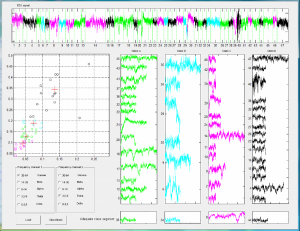
Figure 6: Graphical user interface for signal segments classification into the given number of classes and detection of typical signal segments closest to cluster centers
The paper studies the influence of signal features definition to the compactness of resulting clusters using wavelet transform as a tool for signal segments analysis in the time-scale domain. Proposed methods of multi-channel signal analysis including their filtering, principal component analysis and signal features classification are designed as graphical user interfaces in the MATLAB environment to allow simple signal analysis and processing. The compactness of resulting clusters is numerically studied through distances of class individuals and their center.
Further research will be devoted to the more detail analysis of signal segments features to find clusters with their individuals as close to cluster centers as possible. Further studies will be devoted to extensive application of methods proposed including the study of correlation between EEG observations and MR image analysis.
Acknowledgement
Real EEG signals have been observed by the Neurocenter Caregroup in Rychnov nad Knňěznou. The dual-tree complex wavelet transform library has been kindly provided by prof. N. Kingsbury [9] from the Engineering Department of the University of Cambridge, U.K. The paper has been supported by the specific university research of Ministry of Education, Youth and Sports of the Czech Republic No.21/2010 and the Research grant No. MSM 6046137306.
References
- R. Anderson, N. Kingsbury, and J. Fauqueur. Rotation-Invariant Object Recognition Us- ing Edge Profile Clusters. In The European Signal Processing Conference EUSIPCO-06. EURASIP, 2006.
- N.P. Castellanos and V.A. Makarov. Recovering EEG Brain Signals: Artifact Suppres- sion with Wavelet Enhanced Independent Component Analysis. Journal of Neuroscience Methods, 158(2):300–312, 2006.
- C. Chaux, J. C. Pesquet, and L. Duval. Noise Covariance Properties in Dual-Tree Wavelet Decomposition. IEEE Transaction on Information Theory, 53(12):4690–4700, December 2007.
- D. I. Choi and S. H. Park. Self-Creating and Organizing Neural Networks. IEEE Trans. Neural Networks, 5(4):561–575, July 1994.
- W. J. Fitzgerald, J. J. K. O. Ruanaidh, and J. A. Yates. Generalised Changepoint Detection. Technical report, University of Cambridge, U.K., 1994.
- A. Glavinovitch, M.N.S. Swamy, and E.I. Plotkin. Wavelet-Based Segmentation Techniques in the Detection of Microarousals in the Sleep EEG. In 48th Midwest Symposium on Circuits and Systems, pages 1302–1305. IEEE, 2005.
- S. Haykin. Neural Networks. IEEE Press, NY, 1994.
- P. Johankhani, V. Kodogiannis, and K. Revett. EEG Signal Classification Using Wavelet Feature Extraction and Neural Networks. In Int. Symp. on Modern Computing, JVA06, pages 120–124. IEEE, 2006.
- N. G. Kingsbury. Complex Wavelets for Shift Invariant Analysis and Filtering of Signals. Journal of Applied and Computational Harmonic Analysis, 10(3):234–253, May 2001.
- D. E. Newland. An Introduction to Random Vibrations, Spectral and Wavelet Analysis. Longman Scientific & Technical, Essex, U.K., third edition, 1994.
- M. Nixon and A. Aguado. Feature Extraction & Image Processing. Elsevier, Amsterdam, 2004.
- Saeid Sanei and J. A. Chambers. EEG Signal Processing. Wiley – Interscience, 2007.
- I. W. Selesnick, R. G. Baraniuk, and N. G. Kingsbury. The Dual-Tree Complex Wavelet Transform. IEEE Signal Processing Magazine, 22(6):123–151, 2005.
- S. V. Vaseghi. Advanced Digital Signal Processing and Noise Reduction. John Wiley & Sons Ltd, 2006.
Co-authors of this paper are MUDr Oldřich Vyšata, Prof. Aleš Procházka, Institute of Chemical Technology Department of Computing and Control Engineering, Prague


04. Júl, 2014 o 7:44
i want code for my research purpose
05. Jún, 2015 o 22:30
Dear sir,
excuse me could you send me this code
03. August, 2015 o 13:12
my name is farida kamal. i am a researcher at faculty of computer science ain shams university. my master is on signal processing so i need this code for my research.
thank you
06. August, 2015 o 19:50
I work at hospital for epilepsy and detection I work interdisciplinary filed
can you send me this code
20. Február, 2016 o 10:16
Nice work, is there a way you can add more details about the analysis steps, or provide a link for the codes used?